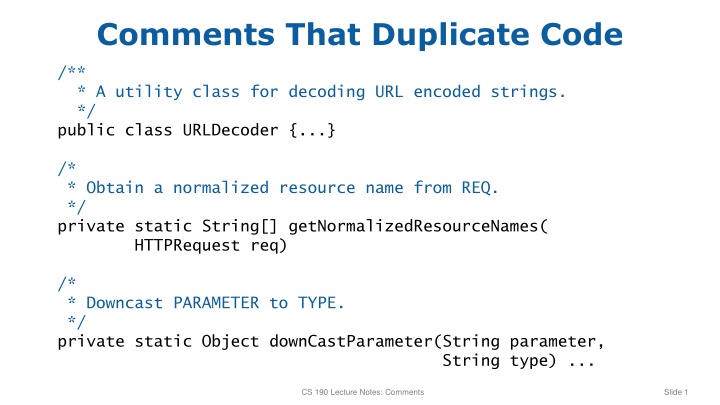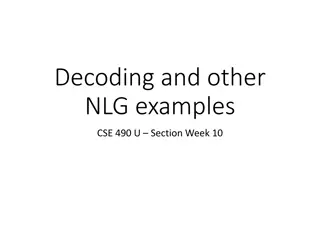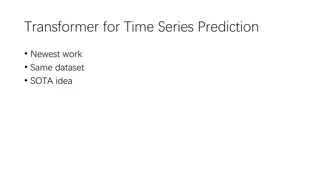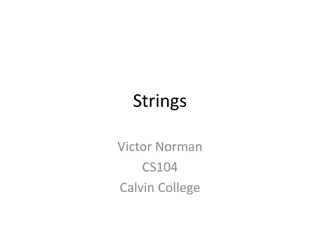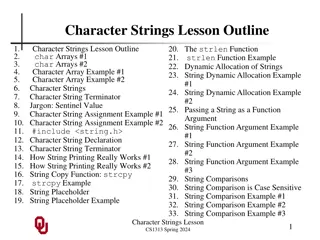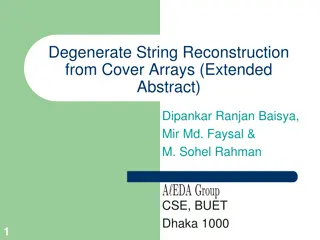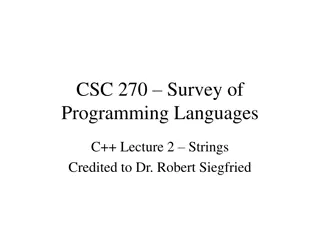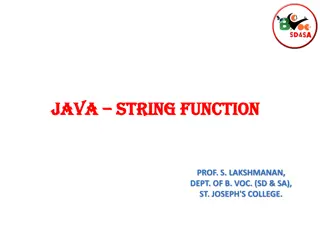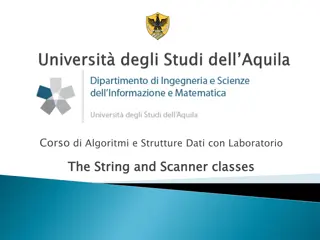Decoding URL Encoded Strings Utility Class
This content discusses a utility class for decoding URL encoded strings, providing insights into obtaining normalized resource names from requests and downcasting parameters to specific types. The examples include comments, code snippets, and references to lecture notes, highlighting various aspects of code optimization and documentation practices.
Download Presentation

Please find below an Image/Link to download the presentation.
The content on the website is provided AS IS for your information and personal use only. It may not be sold, licensed, or shared on other websites without obtaining consent from the author.If you encounter any issues during the download, it is possible that the publisher has removed the file from their server.
You are allowed to download the files provided on this website for personal or commercial use, subject to the condition that they are used lawfully. All files are the property of their respective owners.
The content on the website is provided AS IS for your information and personal use only. It may not be sold, licensed, or shared on other websites without obtaining consent from the author.
E N D
Presentation Transcript
Comments That Duplicate Code /** * A utility class for decoding URL encoded strings. */ public class URLDecoder {...} /* * Obtain a normalized resource name from REQ. */ private static String[] getNormalizedResourceNames( HTTPRequest req) /* * Downcast PARAMETER to TYPE. */ private static Object downCastParameter(String parameter, String type) ... CS 190 Lecture Notes: Comments Slide 1
Use Different Words // The horizontal padding of each line in the text. private static final int textHorizontalPadding = 4; // The amount of blank space to leave on the left and // right sides of each line of text, in pixels. private static final int textHorizontalPadding = 4; CS 190 Lecture Notes: Comments Slide 2
Missing Information // Value of counter when a particular event occurred. uint64_t count; // Cumulative count of last-level cache misses when // this event was recorded. uint64_t missCount; CS 190 Lecture Notes: Comments Slide 3
Comment Not Specific Enough /// Current offset in resp Buffer uint32_t offset; /// Offset in this buffer of the first object that hasn t /// been returned to the client. uint32_t offset; CS 190 Lecture Notes: Comments Slide 4
Comments at Wrong Level // If there is a LOADING readRpc using the same session as PKHash // pointed by assignPos, and the last PKHash in that readRPC is // smaller than current assigning PKHash, then we put assigning // PKHash into that readRPC. uint8_t readActiveRpcId = RPC_ID_NOT_ASSIGNED; for (uint8_t i = 0; i < NUM_READ_RPC; i++) { if (session == readRpc[i].session && readRpc[i].status == LOADING && readRpc[i].maxPos < assignPos && readRpc[i].numHashes < MAX_PKHASHES_PERRPC) { readActiveRpcId = i; break; } } // Try to append the current key hash onto an existing // RPC to the desired server that hasn t been sent yet. CS 190 Lecture Notes: Comments Slide 5
Higher Level Documentation if (numProcessedPKHashes < readRpc[i].numHashes) { // Some of the key hashes couldn't be looked up in this request (either // because they aren't stored by the server, because the server crashed, // or because there wasn't enough space in the response message). Mark // the unprocessed hashes so they will get reassigned to new RPCs. for (size_t p = removePos; p < insertPos; p ++) { if (activeRpcId[p] == i) { if (numProcessedPKHashes > 0) { numProcessedPKHashes--; } else { if (p < assignPos) assignPos = p; activeRpcId[p] = RPC_ID_NOT_ASSIGNED; } } } } CS 190 Lecture Notes: Comments Slide 6
Index Lookup Example query = new IndexLookup(table, index, key1, key2); while (true) { object = query.getNext(); if (object == null) { break; } ... process object ... } CS 190 Lecture Notes: Comments Slide 7
Class Documentation, Original /** * This class implements the client side framework for index range lookups. It * manages a single LookupIndexKeys RPC and multiple IndexedRead RPCs. Client side * just includes "IndexLookup.h" in its header to use IndexLookup class. * Several parameters can be set in the config below: * - The number of concurrent indexedRead RPCs * - The max number of PKHashes a indexedRead RPC can hold at a time * - The size of the active PKHashes * * To use IndexLookup, the client creates an object of this class by providing all * necessary information. After construction of IndexLookup, client can call getNext() * function to move to next available object. If getNext() returns false, it means we * reached the last object. Client can use getKey/getKeyLength/getValue/getValueLength * to get object data of current object. */ class IndexLookup { private: /// Max number of concurrent indexedRead RPCs static const uint8_t NUM_READ_RPC = 10; /// Max number of PKHashes that can be sent in one indexedRead RPC static const uint32_t MAX_PKHASHES_PERRPC = 256; /// Max number of PKHashes that activeHashes can hold at once. static const size_t MAX_NUM_PK = (1 << LG_BUFFER_SIZE); CS 190 Lecture Notes: Comments Slide 8
Class Documentation, Improved /** * This class implements the client side framework for index-based queries. * * To start a range query, a client creates an instance of this class. * The client can then call getNext() to move to next available object. * If getNext() returns false, it means we reached the last object. * If getNext() returns true, client can use getKey() and/or getKeyLength() * and/or getValue() and/or getValueLength() to get information about * that object. */ class IndexLookup { ... } CS 190 Lecture Notes: Comments Slide 9
Documenting APIs /** * Check if the next object is RESULT_READY. This function is implemented in a DCF * module, each execution of isReady() tries to make small progress, and getNext() * invokes isReady() in a while loop, until isReady() returns true. * * isReady() is implemented in a rule-based approach. We check different rules * following a particular order, and perform certain actions if some rule is satisfied * * \return * True means the next Object is available. Otherwise, return false. */ bool IndexLookup::isReady() { ... } * This method returns an indication of whether the indexed read has made enough progress * for getNext to return immediately without blocking. In addition, this method does most * of the real work for indexed reads, so it must be invoked (either directly, or * indirectly by calling getNext) in order for the indexed read to make progress. * * \return * True means at least one object is available, so the next invocation of getNext * will not block; false means getNext may block. CS 190 Lecture Notes: Comments Slide 10
Good Loop Comment // Each iteration extracts one request from the request message, increments // the corresponding object, and appends the response to the response message. for (uint32_t i = 0; ; i++) { const WireFormat::MultiOp::Request::IncrementPart *currentReq = rpc->requestPayload->getOffset< WireFormat::MultiOp::Request::IncrementPart>(reqOffset); if (currentReq == NULL) { respHdr->common.status = STATUS_REQUEST_FORMAT_ERROR; break; } reqOffset += sizeof32(WireFormat::MultiOp::Request::IncrementPart); const void* stringKey = rpc->requestPayload->getRange( reqOffset, currentReq->keyLength); reqOffset += currentReq->keyLength; ... } CS 190 Lecture Notes: Comments Slide 11
Cross-Module Checklist typedef enum Status { STATUS_OK = 0, STATUS_UNKNOWN_TABLET = 1, STATUS_TABLE_DOESNT_EXIST = 2, ... STATUS_INVALID_PARAMETER = 30, STATUS_MAX_VALUE = 30, // Note: if you add a new status value you must make the following additional updates: // * Modify STATUS_MAX_VALUE to have a value equal to the largest defined status // value, and make sure its definition is the last one in the list. This value // is used primarily for testing. // * Add new entries in the tables "messages" and "symbols" in Status.cc. // * Add a new exception class to ClientException.h // * Add a new "case" to ClientException::throwException to map from the status value // to a status-specific ClientException subclass. // * In the Java bindings, add a static class for the exception to ClientException.java // * Add a case for the status of the exception to throw the exception in // ClientException.java // * Add the exception to the Status enum in Status.java, making sure the status is // in the correct position corresponding to its status code. } CS 190 Lecture Notes: Comments Slide 12
Design Notes File Zombies ------- A zombie is a server that is considered dead by the rest of the cluster; any data stored on the server has been recovered and will be managed by other servers. However, if zombie is not actually dead (e.g. it was just disconnected from the other servers for a while) two forms of inconsistency can arise: * A zombie server must not serve read requests once replacement servers have taken over; otherwise it may return stale data that does not reflect writes accepted by the replacement servers. * The zombie server must not accept write request once replacement servers have begun replaying its log during recovery; if it does, these writes may be lost (the new values may not be stored on the replacement servers and thus will not be returned by reads). RAMCloud uses two techniques to neutralize zombies. First, ... ... Timing-Dependent Tests ---------------------- Several unit tests have timing dependencies. For example, ... CS 190 Lecture Notes: Comments Slide 13
Design Notes File, contd if (probesWithoutResponse >= MAX_FAILED_PROBES) { // See "Zombies" in designNotes. MasterService::Disabler disabler(context->masterService); CoordinatorClient::verifyMembership(context, ourServerId); probesWithoutResponse = 0; } CS 190 Lecture Notes: Comments Slide 14
